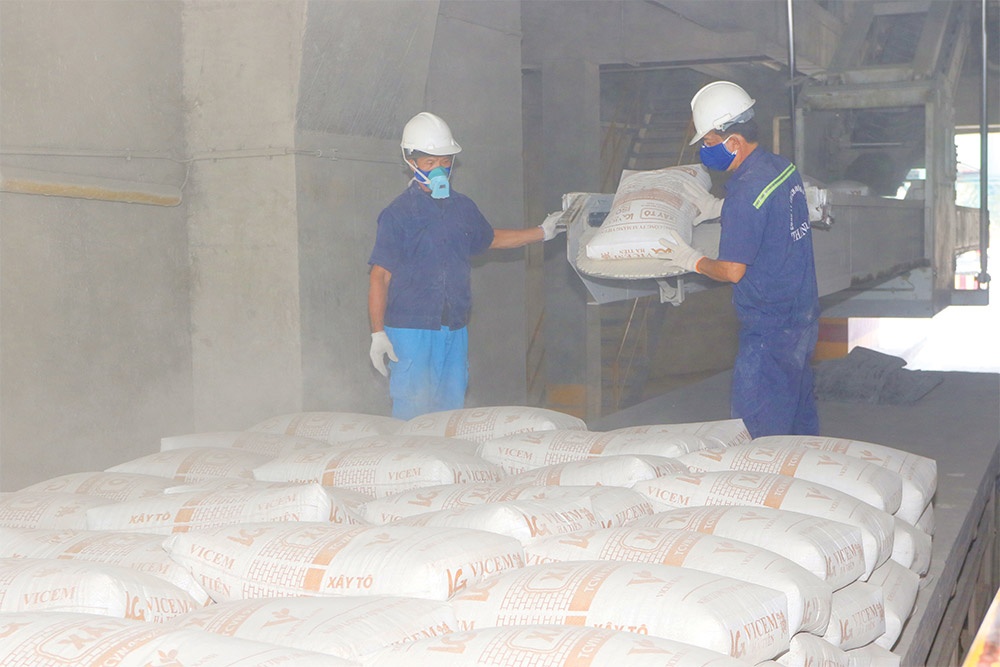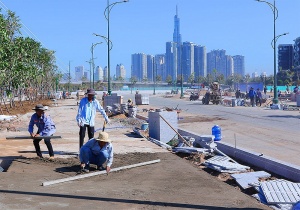Cement export strategies in good stead
 |
| Vietnam is having to compete with its neighbours to export cement to Central America, Africa, and more, photo Le Toan |
Since December, at least half a dozen vessels have anchored at Long Son Bai Ngoc Port to receive cement for export to the US for Long Son Cement of the north-central province of Thanh Hoa.
More cement producers, such as Nghi Son, Ha Tien, Thanh Thang, and Xuan Thanh have also been successful in securing export contracts to the US market.
For instance, last August, Vicem Ha Tien and Nghi Son Cement completed their first export shipments to the US.
The moves mark a leap forward in the strategy to bring Vietnamese cement products to nations around the world, particularly to demanding markets.
One industry expert told VIR that the cement sector incurs serious imbalance in supply and the demand, and the output scale is about 120 million tonnes a year, yet production might be much higher.
“Consumption just approximates 60 million tonnes a year, meaning half of the output is redundant. In this context, cement producers have ramped up efforts to bolster export to avoid inventory. Local producers might even accept meagre margins to embrace export contracts,” he explained.
Besides that, most export orders to the US are of modest volumes in the range of tens of thousands of tonnes.
For instance, the export shipment of Xuan Thanh Cement to the US last July weighed 55,000 tonnes, while the shipment of Nghi Son Cement to the US last May hit 31,500 tonnes.
Several other producers with exported shipments to the US earlier also had common volumes of 30,000-50,000 tonnes for each batch.
For producers, the most efficient method is selling products in the domestic market, with a short distance from ports.
Due to output redundancy, for years many local cement producers have propelled export, with 2021 being the peak year when nearly 46 million tonnes of cement and clinker were exported, and 80 per cent of the products went to markets such as China, the Philippines, Bangladesh, and several in the Middle East.
In 2023, Vietnam exported more than 31.3 million tonnes of cement and clinker, yielding over $1.32 billion, down 1.2 per cent in volume and 4.1 per cent in value on-year.
Last year also marked the second consecutive year with a sharp decline in the export volume of about 14 million tonnes compared to 2021.
Such a decline, however, is not surprising businesses in the sector. Le Nam Khanh, CEO of Vietnam state-run Cement Industry Corporation (Vicem), noted that besides a dip in volume, the export price of cement and clinker is also receding.
The export price at Quang Ninh Port has plunged compared to late 2022, with cement export price down $5-6 per tonne, and that of clinker shed $9-10 per tonne.
“Several of our members cannot export as they would like to, as the export price fell to such a low level that they can’t offset the production costs,” said Khanh.
The export prospects in 2024 are deemed as subdued as Vicem forecasts in the best-case scenario the export volume to be only up slightly, to 1.5-2 per cent, due to stiff competition from export items from China, Turkey, and several neighbouring markets.
China’s real estate market has also yet to show signs of rebound in 2024, leading to a cement glut in the domestic market. China is currently competing head-on with Vietnam for exporting cement to major export markets such as the Philippines, Central America, and South Africa.
Luong Quang Khai, a senior cement expert, assumed that the US is not an ideal destination for Vietnamese cement due to still modest export volume, irrespective of the fact that Vietnamese cement has to compete with similar sources from Turkey.
“Light at the end of the tunnel is that Central and South America is forecast to catch cement export growth when several countries in this region avail of the benefits of the Comprehensive and Progressive Agreement for Trans-Pacific Partnership, with zero tariffs when importing cement from Vietnam,” Khai said.
 | Cement groups take on tough period Amid unprecedented complexities, cement producers are hoping for breakthroughs in public projects to stimulate demand and accelerate consumption. |
What the stars mean:
★ Poor ★ ★ Promising ★★★ Good ★★★★ Very good ★★★★★ Exceptional
 Tag:
Tag:
Related Contents
Latest News
More News
- Mondelez Kinh Do - a chapter of purpose-led leadership in Vietnam (December 18, 2025 | 09:44)
- VNPAY services receive the highest-level PCI DSS international security certificates for six consecutive years (December 17, 2025 | 23:47)
- PPL extends its reach into ASEAN (December 17, 2025 | 15:44)
- Over 600 BUV graduates meeting quality benchmarks across triple quality assurance levels (December 17, 2025 | 13:00)
- HEINEKEN Vietnam partners with Ho Chi Minh City Traffic Police on road safety drive (December 17, 2025 | 09:42)
- BUV and China’s CSCSE sign MoU to boost educational cooperation (December 17, 2025 | 08:00)
- PVT Logistics honoured with ‘Fast Enterprise Award’ at APEA 2025 (December 16, 2025 | 18:22)
- Empowering Sustainable Data Centers with Smart Infrastructure Solutions (December 16, 2025 | 13:59)
- Vietjet wins gold ESG transport sustainability award in Taiwan (China) (December 13, 2025 | 22:03)
- Legal framework completed for national digital transformation (December 13, 2025 | 21:55)
























 Mobile Version
Mobile Version